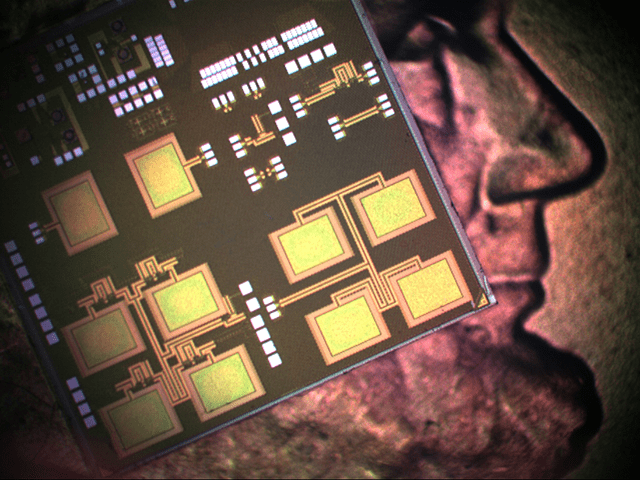Sub-Terahertz RFICs arrive at NYU-Tandon

NYU WIRELESS researcher, Felix Gutierrez, recently received a core component of his Ph.D. research: Radio Frequency Integrated Circuits (RFICs) fabricated with on-chip antennas. Using IBM’s 45nm Silicon-On-Insulator (SOI) CMOS technology, Felix designed an 180 GHz RFIC with a phased 4-element patch antenna array to test semiconductor capabilities at millimeter-wave and sub-terahertz frequencies. While CMOS technology has been traditionally used to create inexpensive digital circuits such as computer processors, wireless researchers are pushing the limits of CMOS transistors to operate at higher mmWave/sub-THz frequencies for broadband wireless communications, sensors, vehicular radar, spectroscopy, and medical imaging/telemetry.
Pictured above resting on a U.S. penny, these small prototype wireless chips will form the heart of future devices operating at hundreds of gigahertz and provide Gbps to end-users. Using a Cascade wafer probe station and a Rohde & Schwarz Vector Network Analyzer, Felix will test and measure the impedance, efficiency, bandwidth, and directionality of this RFIC antenna array which can be steered electrically to transmit and receive the best possible directions–a key feature for future 5G cellular.
Felix is co-supervised by Prof. Ted Rappaport at NYU/NYU-Tandon and Prof. Deji Akinwande at the University of Texas-Austin. Funding for this project is provided by the DARPA LEAP program and the NYU WIRELESS Industrial Affiliates.

 2025 Brooklyn 6G Summit — November 5-7
2025 Brooklyn 6G Summit — November 5-7 Sundeep Rangan & Team Receive NTIA Award
Sundeep Rangan & Team Receive NTIA Award 2025 Open House
2025 Open House








